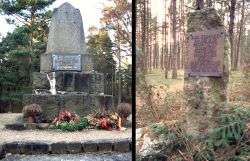Battle of the Göhrde
| ||||||||||||||||||||||||||||
The battle of the Göhrde was a battle of the War of the Sixth Coalition on 18 September 1813 between French and Coalition troops at Göhrde in Germany. The French troops were defeated and withdrew to Hamburg.[1]
Site
It occurred near what is now the site of the Göhrde State Forest (Staatsforst Göhrde), near Dannenberg, near Lüneburg. At that time this area belonged to the electorate of Braunschweig-Lüneburg (Hanover), which had been occupied by the French since 1803. The battlefield lies on the border between the modern-day districts of Lüneburg and Lüchow-Dannenberg, between Oldendorf an der Göhrde and Göhrde.
Context
In spring 1813, Russian troops under Friedrich Karl von Tettenborn forced the French out of Hamburg and some northern areas of Hanover. In the wake of Prussia's reentry into the war against France, the eastern areas of Hanover also rose against Napoleon. Wallmoden then received overall command of all the Allied troops on the Lower Elbe: troops from Prussia, Russia, the United Kingdom, Hanover, Hamburg, Mecklenburg and Sweden, including the Russian German legion, the Lützow Free Corps, the Hanseatic Legion and a part of the King's German Legion, under the overall command of Generalleutnant Ludwig von Wallmoden-Gimborn. Part of the British contingent was the newly formed Rocket Brigade under Capt Richard Bogue. On 7 September Bogue marched with half his brigade to join the main Army of the North, near Wittenburg. The other half of the brigade, under Lieut Thomas Fox Strangways,[2] joined the 4th Cavalry Division of General von Dornberg under General Wallmoden.[3]
The Free Corps such as that from Lützow again and again attacked French supply lines and bases in the area around Mecklenburg, south of the Elbe. The XIII Corps there, under marshal Davout, had up to this point behaved quite passively, restricting itself to holding Wallmoden's corps in check. As an anti-skirmishes measure, in September Davout sent general Pécheux on the western Elbufer with a brigade of 50th infantry division and moved on Lüneburg with 3,000 troops. After completing his mission, Pécheux was ordered to rejoin the French troops in Magdeburg. Wallmoden's corps advanced on Dömitz on 15 September with 12,300 men, crossed the Elbe, marched toward the Frenchmen and set up camp in Dannenberg.
Course

The French division under Pécheux decided to attack the allies. On the early afternoon of 18 September 1813, it reached the Steinker Höhen (Steinker Heights) in Nahrendorf and gave battle. Whilst Wallmoden’s infantry attacked the centre, Dornberg with the KGL cavalry and artillery attacked the enemy’s left. However, Dornberg brought the guns and rockets into action at too great a range; their fire was ineffective and General Lyon’s infantry attack was held up. The French began to retire, formed in squares, and Strangways advanced to bring the rockets into action “close under the fire of the enemy’s infantry”.[4] The 3rd KGL Hussars broke two squares and the rockets spread such terror through the retiring ranks that order could no longer be preserved, and breaking, the French fled in all directions.[5]
Results
The battle was the first victory over the French troops garrisoning Germany, and interrupted the link between XIII Corps under marshal Davout (with its headquarters in Hamburg) and Napoleon's main army (then in Saxony) and the French armies' supply-lines across Hanover from France to Magdeburg and Berlin. This result was critical for the outcome of the Battle of Leipzig soon afterwards. This was the first battle in which the newly developed Congreve Rocket had been successfully deployed in action. At the Battle of Leipzig, The Rocket Brigade, under Bogue and Strangways, would make a significant attack whilst attached to the Swedish Corps of Crown Prince Bernadotte.
Commemorations

A large stone monument stands as a memorial to the battle in 1839, at a site now north of Bundesstraße 216 about 2 km behind Oldendorf in Richtung Dannenberg.
1000 dead soldiers from both sides were buried in a mass grave in the forest, 100m from where the memorial is sited. This grave was rediscovered in 1985.
Rudolf von Bennigsen's father Karl von Bennigsen fought in this battle (as a lieutenant), as did the famous freedom fighter Eleonore Prochaska. She had disguised herself as a man and joined the Lützow Free Corps. During the battle she was wounded and soon afterwards succumbed to her injuries in the hospital at Dannenberg.
A reconstruction of the battle occurs every two years at Dahlenburg. At the Heimatmuseum in the town a diorama of the battle is on permanent display, with 1500 tin soldiers.
References
- ↑ Chappell, Mike. The King's German Legion (2): 1812-16. Osprey Publishing. p. 7. ISBN 978-1-85532-997-3.
- ↑ a nephew of the 2nd Earl of Ilchester
- ↑ Page 173, II, L Ludlow Beamish, History of the Kings German Legion in 2 vols
- ↑ London Gazette, 1813 No 16784 – Walmoden’s dispatch
- ↑ Pages 194-198, II, Ludlow Beamish
External links
| Wikimedia Commons has media related to Battle of the Göhrde. |
Coordinates: 53°09′11″N 10°50′06″E / 53.153°N 10.835°E